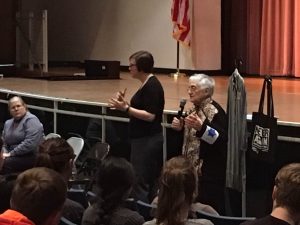Holocaust Survivor Comes to RHS to Share Unique Story with Students (Part One)
March 17, 2016
This is the first in a three-part series about the life of Holocaust survivor Edith Lowy. Watch for the next installment, coming soon.

As a child growing up in Czechoslovakia during the 1930s, Edith Lowy had had no idea that her carefree, idyllic days were numbered. Little did she know that over the seven years following the Polish invasion of Czechoslovakia, she would come close to death six timesa��just because she was Jewish.
Lowy, who came to speak to RHS students Feb. 23 as part of Montgomery College’s “Portraits of Life” program, lived in the small mining town of Poruba, Czechoslovakia (near the Polish border and now part of the Czech Republic), with her father Rudolf and her mother Irena, who owned a general store, and her brother Erik, two years her junior.
Lowy was nine years old when the Polish occupation began in September 1938, and had turned 10 by the time Germany invaded the country in March 1939, taking the majority of the land. As the Nazi occupiers began enforcing anti-Semitic segregation rules similar to Germany’s Nuremberg Laws, Jews were no longer allowed to use public transportation, visit public entertainment venues or practice law or medicine. Signs appeared in front of many stores carrying messages such as “Entrances to Jews and dogs forbidden.”
Around this time, Lowy’s family was given one month to leave the Polish-Czechoslovak border area. The Lowys chose not to move westward, further into the Czech part of Czechoslovakia, because most of the country was in German hands. They instead fled to Prokocim, Poland, a city near Krakow where some of Lowy’s grandfather’s relatives lived. The family did not know that in fewer than six months, the German army would sweep through there as well, starting World War II.
In Poland, the Lowy family began working out an emigration plan. However, they spent so much time planning that they could no longer leave due to an impending German advance. The Lowys, now joined by Irena’s younger sister Polly and her husband, were forced to flee towards the Soviet front, finding work at farms along the way. However, Germany invaded Poland Sept. 1, 1939.
The Germans brought with them anti-Semitic segregation laws similar to those they had used in Czechoslovakia. All Jews ages 10 and older were now required to wear Star of David armbands, exposing them to harassment and violence from non-Jewish Poles. The Lowys decided that their best option was to return to Prokocim. Not long after they returned, they were transferred to a ghetto in the city of Wieliczka.
Lowy and her family lived in the Wieliczka ghetto for several months. One day, the Nazis rounded up all men ages 16 to 65 in the ghetto, including Lowy’s father and uncle. When the men returned, they revealed that they had been taken away to do forced labor on the train tracks. Shortly afterwards, some German supervisors let slip a shocking secret: the ghetto’s Jews were to be deported soon.
Then the next chapter of Lowy’s story began: life on the run from the Nazis and their sympathizers. The family was on edge because Irena had recently disappeared; they later found out that she had perished in the crematorium at one of the first Nazi extermination camps set up in Poland, most likely Be A?ec.
For three months, the family hid in crates in the basement of an officers’ building, sheltered by two kind German officers. They took food from a Polish woman and a few priests, who had also offered to forge Aryan papers for them. After a disastrous attempt by Lowy to dye her aunt Polly’s hair blonde (to help her pass as non-Jewish), the family decided that their safest option would be to willingly walk into a nearby forced-labor camp in Prokocim so as to avoid the constant threat of discovery by the Nazis, which could get them sent somewhere much worse than a forced-labor camp.
Before long, though, the camp in Prokocim was liquidated and everyone in it was sent to a forced-labor camp called P aszA?w. Many families were separated upon their arrival, including the Lowys. On the second day at P aszA?w, Lowy’s group of inmates began forced labor. On the third day, Lowy was reunited with Rudolf, who told her that Erik had been moved to the other side of the camp. Though they had only been there for three days, Lowy said, “When I saw my father, I could hardly recognize him.” She recalled her shock at the look of pain on his face and said he was already beginning to take on the appearance of an “old man.”
Shortly after Lowy and Rudolf reunited, another tragedy struck the family. The news came that Nazi guards had fatally shot Erik and several other children. Rudolf was forced to bury his own son as part of the 50-man group ordered to deal with the bodies. The Lowys’ troubles were far from over, though. They were soon transferred to yet another forced-labor camp, SkarA?ysko-Kamienna.


